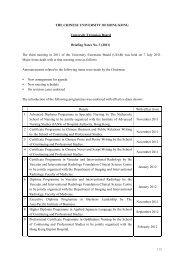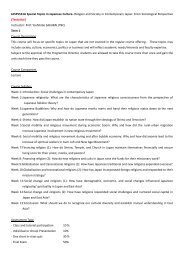ä¸è¼å ¨æ¸ - The Chinese University of Hong Kong
ä¸è¼å ¨æ¸ - The Chinese University of Hong Kong
ä¸è¼å ¨æ¸ - The Chinese University of Hong Kong
Create successful ePaper yourself
Turn your PDF publications into a flip-book with our unique Google optimized e-Paper software.
Wyman Kwok, Education and Thinking 219<br />
Analyzing Research,” and “Critical Thinking in Clinical Inference.” As<br />
revealed in this list, one <strong>of</strong> its prominent features is the teaching <strong>of</strong> CT in<br />
psychology with respect to a wide range <strong>of</strong> psychological topics.<br />
It also illustrates a “psychological approach” <strong>of</strong> teaching CT in general.<br />
Very roughly speaking, under the usual “logical approach,” logical principles<br />
are taught; while under a psychological approach, topics like “cognitive<br />
biases” are taught. An example <strong>of</strong> cognitive biases discussed in the book<br />
is “Thinking with Numbers” (p. 3), which is concerned with the notorious<br />
“anchoring effect.” <strong>The</strong>se two approaches may also be distinguished by<br />
appealing to the reason/cause distinction. <strong>The</strong> logical approach is concerned<br />
with reason — the principles <strong>of</strong> logical reasoning; while a psychological<br />
approach is concerned with cause — the psychological causes <strong>of</strong> judgment.<br />
For instance, when a fallacy like hasty generalization is taught, the logical<br />
approach will explain that the principles <strong>of</strong> reasoning — namely, some<br />
principles <strong>of</strong> inductive logic — were violated in hasty generalization, hence<br />
identifying a fallacy. However, even though someone might know very well<br />
the reasoning behind a hasty generalization, that person might find it difficult<br />
to resist committing the fallacy in daily life. As a matter <strong>of</strong> fact, it is not<br />
difficult to observe people committing trivial fallacies again and again as<br />
a daily routine. But why would they do so <strong>The</strong> key point to note is that<br />
the (perhaps simple) logical reason behind a fallacy is one thing, while the<br />
(perhaps irresistible) psychological cause <strong>of</strong> it is another. A psychological<br />
approach aims at studying the psychological cause behind the committing <strong>of</strong> a<br />
fallacy so that psychological remedy may be suggested. Moreover, since there<br />
may be causes other than psychological ones (e.g., cultural or sociological),

















